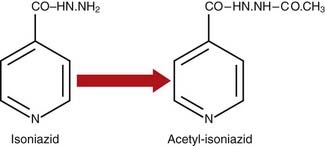CHAPTER 12 Pharmacogenetics
Definition
The term pharmacogenetics was introduced by Vogel in 1959 for the study of genetically determined variations that are revealed solely by the effects of drugs. Pharmacogenetics is now used to describe the influence of genes on the efficacy and side effects of drugs. Pharmacogenomics describes the interaction between drugs and the genome (i.e., multiple genes), but the two terms are often used interchangeably. Pharmacogenetics/pharmacogenomics is important because adverse drug reactions are a major cause of morbidity and mortality. It is also likely to be of increasing importance in the future, particularly as a result of the development of new drugs from information that has become available from the Human Genome Project (see Chapter 5). The human genome influences the effects of drugs in at least three ways. Pharmacokinetics describes the metabolism of drugs, including the uptake of drugs, their conversion to active metabolites, and detoxification or breakdown. Pharmacodynamics refers to the interaction between drugs and their molecular targets. An example would be the binding of a drug to its receptor. The third way relates to palliative drugs that do not act directly on the cause of a disease, but rather on its symptoms. Analgesics, for example, do not influence the cause of pain but merely the perception of pain in the brain.
Drug Metabolism
The metabolism of a drug usually follows a common sequence of events (Figure 12.1). A drug is first absorbed from the gut, passes into the bloodstream, and becomes distributed and partitioned in the various tissues and tissue fluids. Only a small proportion of the total dose of a drug will be responsible for producing a specific pharmacological effect, most of it being broken down or excreted unchanged.
Biochemical Modification
One important biochemical modification of many drugs is conjugation, which involves union with the carbohydrate glucuronic acid. Glucuronide conjugation occurs primarily in the liver. The elimination of morphine and its derivatives, such as codeine, is dependent almost entirely on this process. Isoniazid, used in the treatment of tuberculosis, and a number of other drugs, including the sulfonamides, are modified by the introduction of an acetyl group into the molecule, a process known as acetylation (Figure 12.2).
Kinetics of Drug Metabolism
If a dose–response test is carried out on a large number of subjects, their results can be plotted. A number of different possible responses can be seen (Figure 12.3). In continuous variation, the results form a bell-shaped or unimodal distribution. With discontinuous variation the curve is bimodal or sometimes even trimodal. A discontinuous response suggests that the metabolism of the drug is under monogenic control. For example, if the normal metabolism of a drug is controlled by a dominant gene, R, and if some people are unable to metabolize the drug because they are homozygous for a recessive gene, r, there will be three classes of individual: RR, Rr, and rr. If the responses of RR and Rr are indistinguishable, a bimodal distribution will result. If RR and Rr are distinguishable, a trimodal distribution will result, each peak or mode representing a different genotype. A unimodal distribution implies that the metabolism of the drug in question is under the control of many genes—i.e., is polygenic (p. 143).
Genetic Variations Revealed by the Effects of Drugs
N-Acetyltransferase Activity
Studies in other animal species led to the cloning of the genes responsible for N-acetyltransferase activity in humans. This has revealed that there are three genes, one of which is not expressed and represents a pseudogene (NATP), one that does not exhibit differences in activity between individuals (NAT1), and a third (NAT2), mutations in which are responsible for the inherited polymorphic variation. These inherited variations in NAT2 have been reported to modify the risk of developing a number of cancers, including bladder, colorectal, breast, and lung cancer. This is thought to be through differences in acetylation of aromatic and heterocyclic amine carcinogens.










